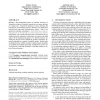Free Online Productivity Tools
i2Speak
i2Symbol
i2OCR
iTex2Img
iWeb2Print
iWeb2Shot
i2Type
iPdf2Split
iPdf2Merge
i2Bopomofo
i2Arabic
i2Style
i2Image
i2PDF
iLatex2Rtf
Sci2ools
MOBIHOC
2008
ACM
2008
ACM
The networking shape of vehicular mobility
Mobility is the distinguishing feature of vehicular networks, affecting the evolution of network connectivity over space and time in a unique way. Connectivity dynamics, in turn, determine the performance of networking protocols, when they are employed in vehicle-based, large-scale communication systems. Thus, a key question in vehicular networking is: which effects does nodes mobility generate on the topology of a network built over vehicles? Surprisingly, such a question has been quite overlooked by the networking research community. In this paper, we present an in-depth analysis of the topological properties of a vehicular network, unveiling the physical reasons behind the peculiar connectivity dynamics generated by a number of mobility models. Results make one think about the validity of studies conducted under unrealistic car mobility and stimulate interesting considerations on how network protocols could take advantage of vehicular mobility to improve their performance. Categori...
Keywords Vehicular Networking | MOBIHOC 2008 | Unrealistic Car Mobility | Vehicular Mobility | Wireless Networks |
| Added | 24 Dec 2009 |
| Updated | 24 Dec 2009 |
| Type | Conference |
| Year | 2008 |
| Where | MOBIHOC |
| Authors | Marco Fiore, Jérôme Härri |
Comments (0)

